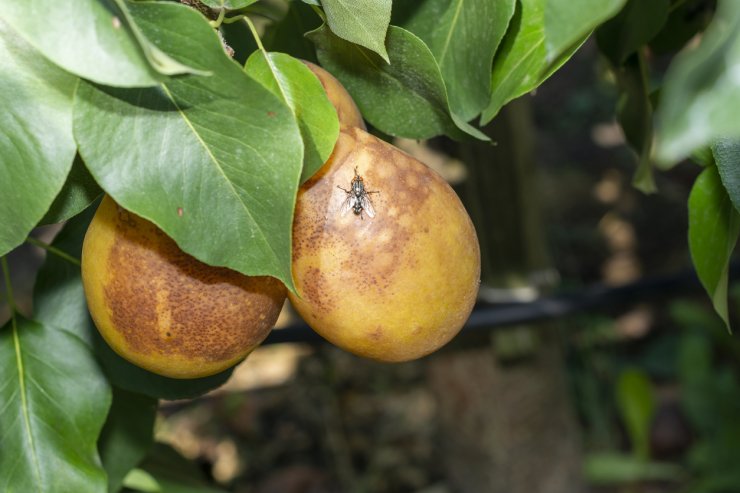
Pear psylla on a pear.
Pear trees may fall victim to local wildlife: rabbits love bark and young branches, and deer love pears. So, consider some chicken wire or netting to protect your crop.
Other pests are harder to control—and often harder to spot.
Pear Psylla look like tiny cicadas. They’re active any time the temperature rises above 40 degrees F. When their eggs hatch, yellowish, wingless nymphs work their way to succulent stems and developing leaves. The nymphs feed on plant sap and secrete a lot of “honeydew,” which drops on leaves and fruit. The honeydew in turn provides a rich growing ground for a sooty black fungus.
There are usually four generations of pear psylla a year. Pear psylla can severely damage a tree, causing partial or complete defoliation, damaged fruit, and reduced fruit production the next year. There’s some evidence that pear psylla may also help transmit fire blight. Contact your local nursery for the best way to address any current pear psylla infestations and for tips on preventing future infections.
Pear Slugs only look like slugs for a short time; they’re actually a type of sawfly. The adults are tiny: just 1/5 inch long. In the spring, the females lay two to five eggs per leaf. The larvae are shiny and slug-like, about 1/3 inch long. The larvae eat the leaves, leaving nothing behind but the veins. The mature larvae eventually drop to the ground and burrow into the soil to pupate, paving the way for a second infestation.
Second-generation pear slug damage is often worse than the first infestation. An infested tree may have reduced growth the following year. For tips on how best to address pear slugs on your trees, check with your local nursery or extension center.
Other pear tree pests include aphids, caterpillars, codling moth, pear blister mite, pear midge, and the pear and cherry slug worm.
Have your pear trees been affected by any pests? How have you handled treating or preventing pests on your pear trees? Please share your experiences with everyone in the comments below.


 Previous
Previous

